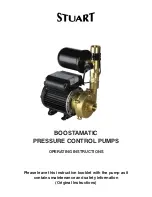
Instruction Manual
P-2800 & P-2800D Hand Pumps - V1.1 www.durapac.com
Page 5 of 12
4.3
Check all system fittings and connections to be sure they are tight and leak free.
4.4
Check oil level in reservoir before operating pump.
4.5
Remove air from the system – Air can accumulate in the hydraulic system during the
initial setup or after prolonged use, causing the cylinder to respond slowly or in an
unstable manner. Should removal of air from pump be required, please follow the
steps in 6.2 – Bleeding Air from the System in the Maintenance Section.
5.0
Operation
IMPORTANT:
This pump is operated with a non-vented reservoir. If the reservoir is subjected to high
pressure, the casing may rupture, causing personal injury and/or equipment damage.
NEVER
attempt to return more oil to the reservoir than it is capable of holding
Do NOT
add extensions to the pump handle. Extensions cause unstable pump
operation
In certain situations the pump handle can "kick back". Always keep your body to the
side of the pump, away from the line of force of the handle
Do NOT
operate a pump that is disconnected from application. If operated in this
condition, the hose and connections will become pressurised. This increases burst
hazard. Damage may occur to pump and its components
The pump may only be operated in a horizontal position as shown.
Figure 1 – Hand Pump Operation
5.1
Before Using the Pump
5.1.1
Check all system fittings and connections to be sure they are tight and leak free.
5.1.2
Check oil level in reservoir before operating pump.
5.2
Using Two-Speed Pumps
:
These pumps provide 2-stage flow. Under no load, the pump operates in the high flow
first stage for rapid advance. When the load is contacted, the pump automatically shifts
to the second stage for building pressure.
For P-2800 or P-2800D models, when pump pressure reaches approximately 27.5 bar,
you must momentarily stop pumping and raise the handle to shift to the high pressure
stage. After the pump shifts, pumping takes less effort.






























